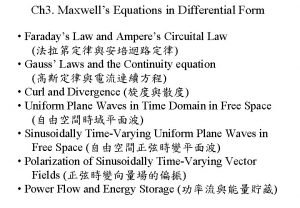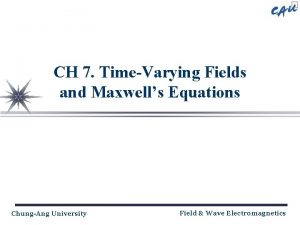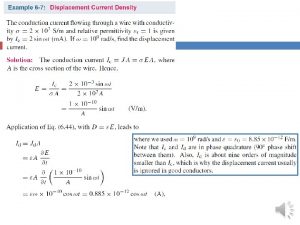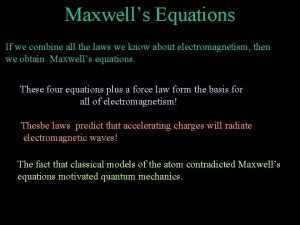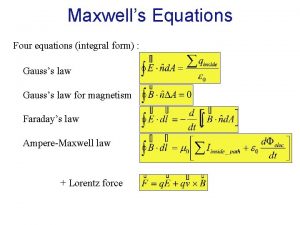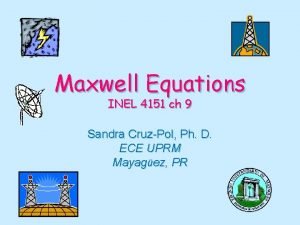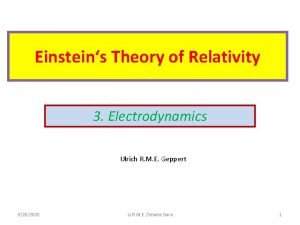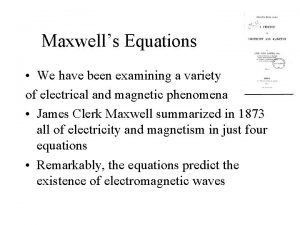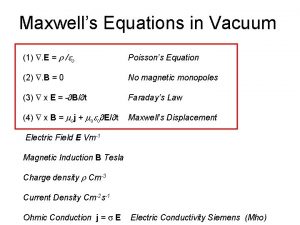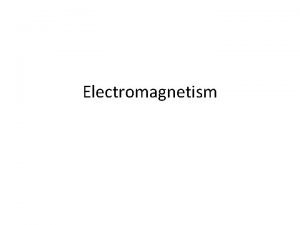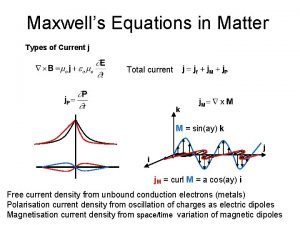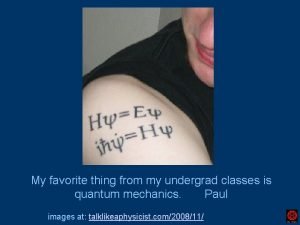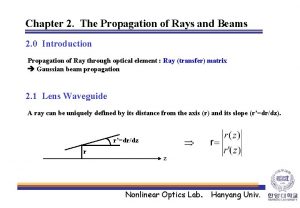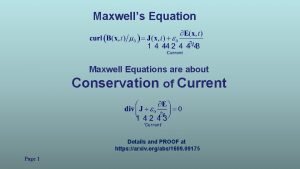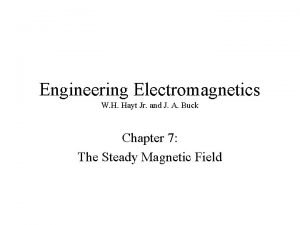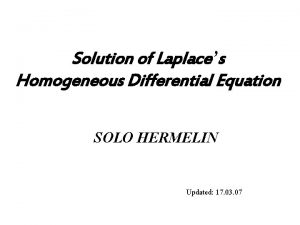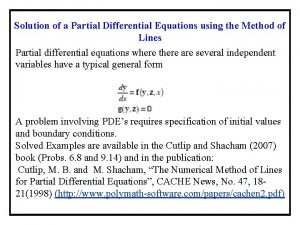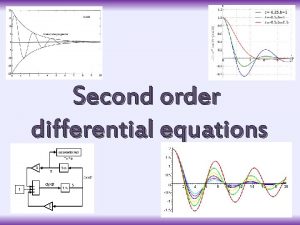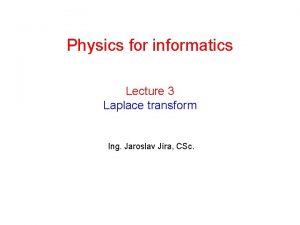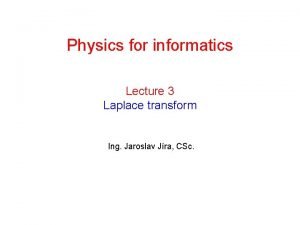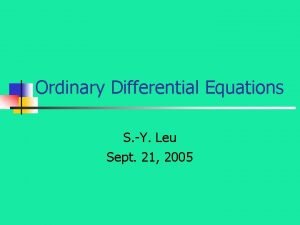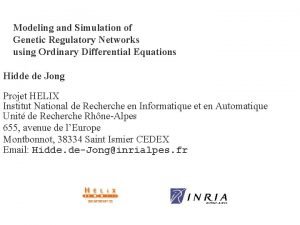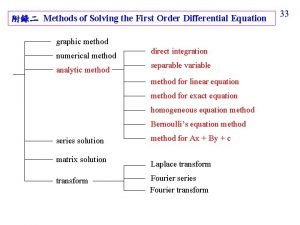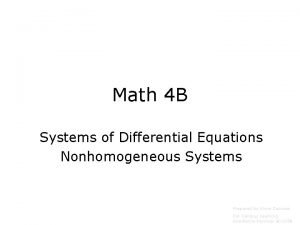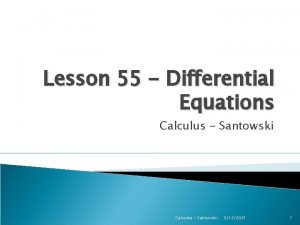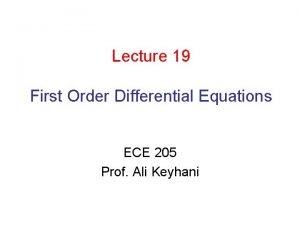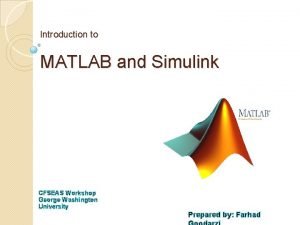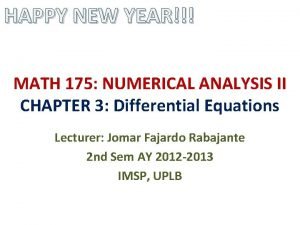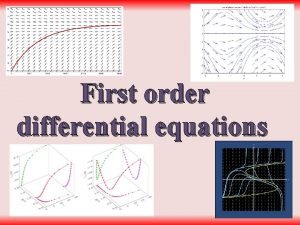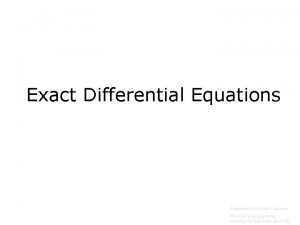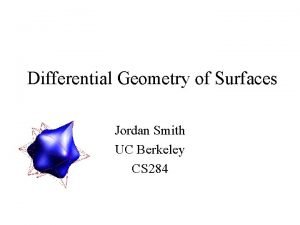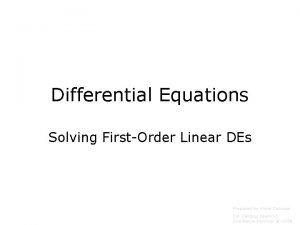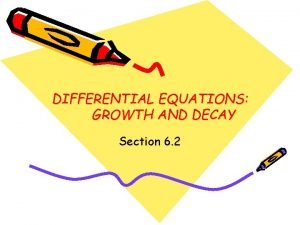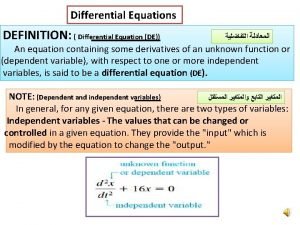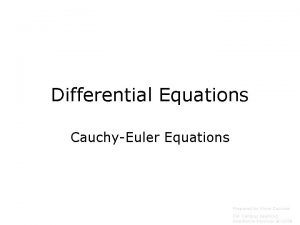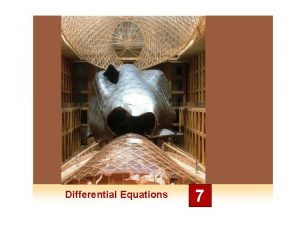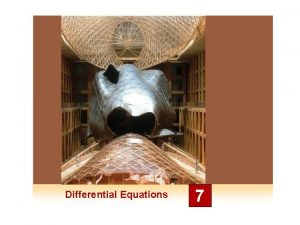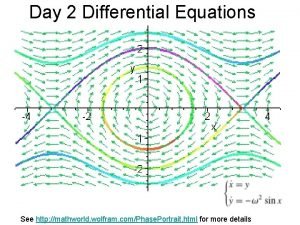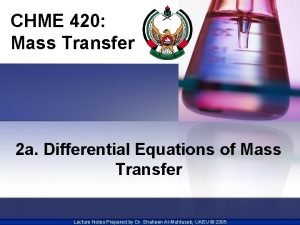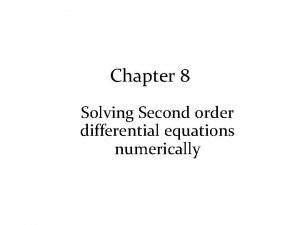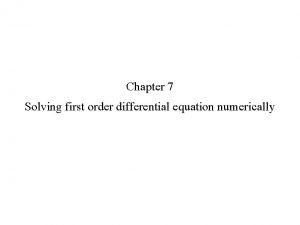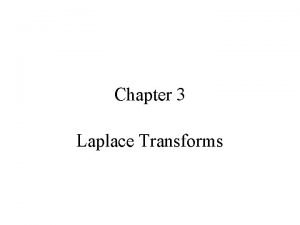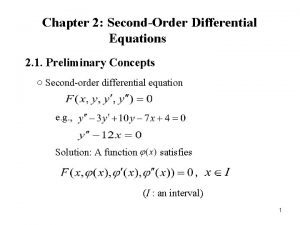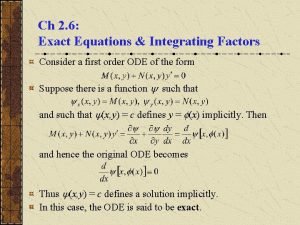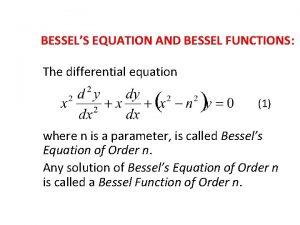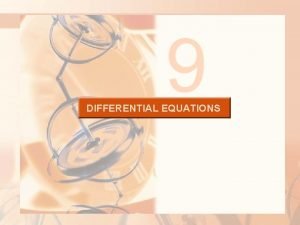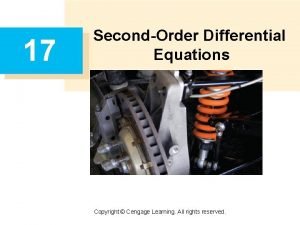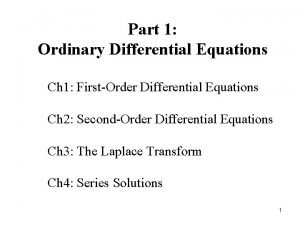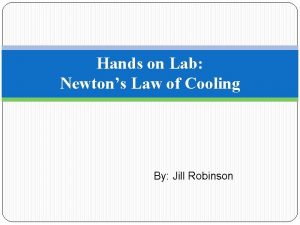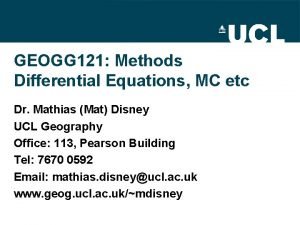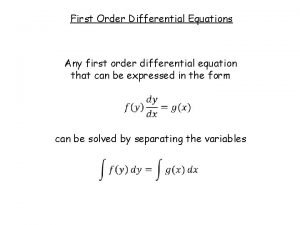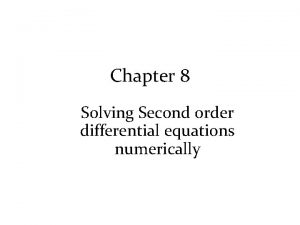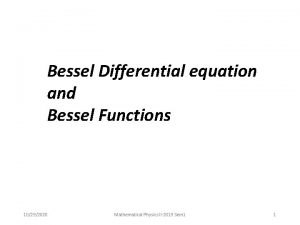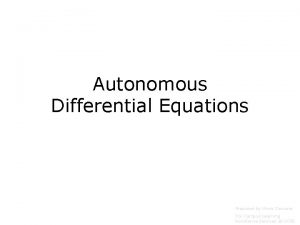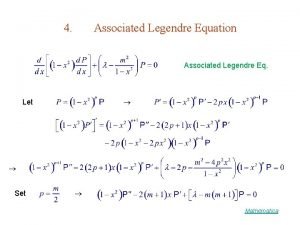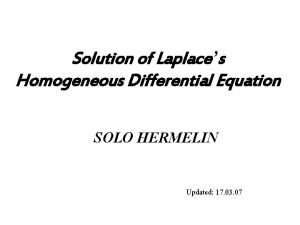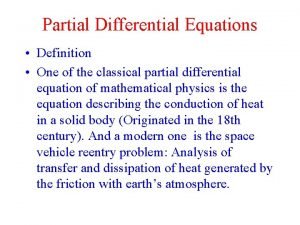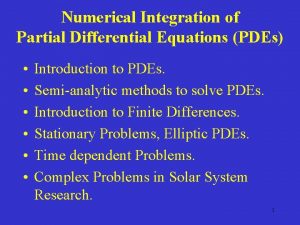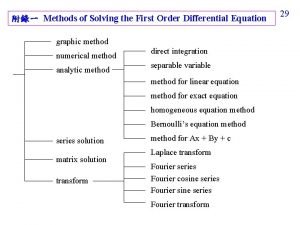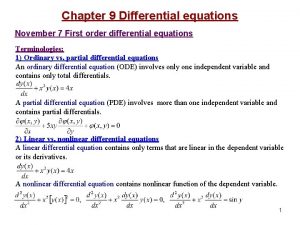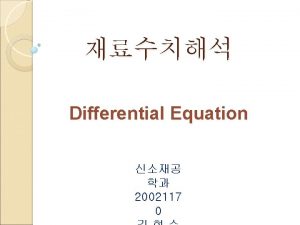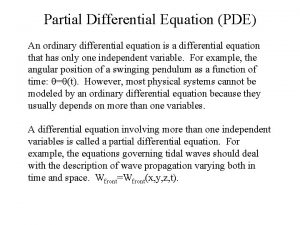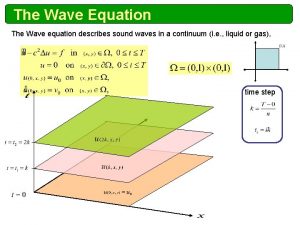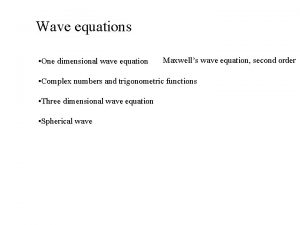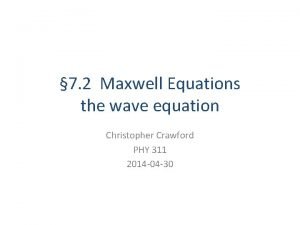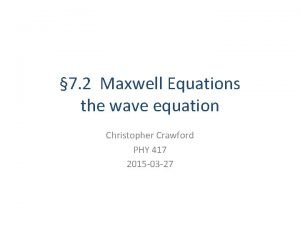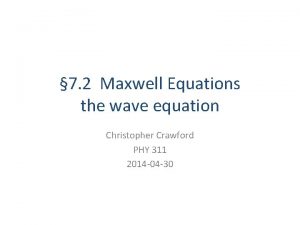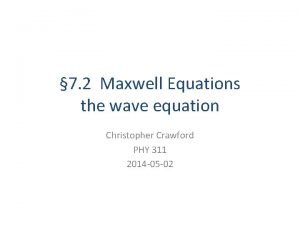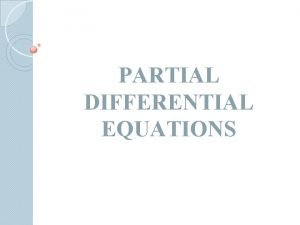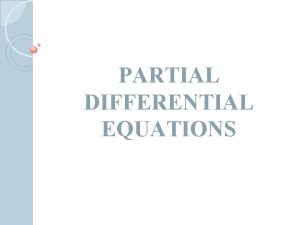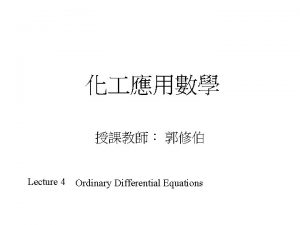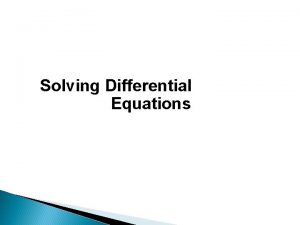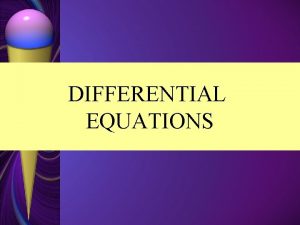MAXWELL EQUATION IN DIFFERENTIAL FORM E M WAVE





























































































- Slides: 93

MAXWELL EQUATION IN DIFFERENTIAL FORM & E. M. WAVE EQUATIONS CHAPTER 2 Dr. Ir. Suwarno

DIFFERENSIASI VEKTOR If A (u) is a vector and u independent variabel then difference in A (u) , A can be expressed as A = A(u + u) - A(u) For small u 0

For position vector from a point at Cartesian r(u) = x(u)ax + y(u)ay + z(u)az

GRADIENT OF A SCALAR FUNCTION For describing gradient following illustration of temperature change is given. At P 1 (x, y, z) temperature is T 1 (x, y, z). At P 2 (x + x, y + y, z + z) temperature is T 2 (x + x, y + y, z + z). Using Taylor expansion T 2 can be obtained from dapat T 1 as follows : + higher order and negligible And therefore T = T 2 - T 1 can be approximated as

If change of coordinate is very small ( x 0, y 0, z 0) then Position differential . d. T = grad T. dr = T. dr where (del) is a differential operator which in Cartesian


Gradient formula


Gradient of a scalar function is conservative i. e. : From the figure :

Example

DIVERGENCE OF VECTOR FIELD Vector F and flux

Consider F as a vector in Cartesian Fluks F out from closed S covered v = x y z is as follows. Since v is a cubic and therefore total flux

To make simple the can be divided for each direction. Flux in X direction Ffron and Fback can be related as Constribution for front and back fluxes is

Using similar way for flux in Y direction An for flux in Z direction

For all surfaces If the results is divided with volume differential v If v 0 then

Divergence of a vector F If operator nabla is is defined as then

Divergences for each coordinate systems

DIVERGENCE THEOREM

EXAMPLE


DIVERGENCE AND MAXWELL EQUATIONS From Gauss Law for electric field From divergence theorem Elimination of dv . ( o. E) = v Using the same way for magnetic field Maxwell equations in diff. form or . (D) = v . B = 0

Gradient and divergence in electrostatics Gradient Potential V Divergence Field E Integration Charge density r

Example In free space potential is expressed as V=2 x 2 y+3 z +100 V Determine E and r at A(1, 1, 1) m

Potential in free space is independent on y and z and only a function of x and expressed graphically below V (volt) 10 0 2 4 6 8 -10 Determine a. Electric field between x=0 and x = 8 b. Charge density c. Total charge in a sphere with radius of 1 m centered at (6, 6, 6) x (m)

CURL OF A VECTOR FIELD Curl indicates net circulation of a vectior field around closed contour( or about a point). For example water flow in a canal with non uniform velocity If F is a vector as function of x, y and z then curl of F can be expressed as Curl F = Curl F x ax + Curl F y ay + Curl F z az

Curl meter for water flow in a canal Z Y Curl V = 0 Curl V > 0 Curl V < 0

Z Y

Curl releases a vertical force


For the case of water flow in a canal at Y-Z plane For F in cartesian

For small contour c, using Taylor expansion Then

Using same way for y component And for z component Complete expression for curl is

Curl in different coordinate systems Cartesian Cylindrical Spherical

Illustration of divergence and Curl

Example

From chapter I for a conductor with radius of a and uniform current I

STOKES THEOREM Surface Integral relates with line integral as AMPERE’s AND DIFFERENTIAL Ampere’s Law FARADAY’S LAWS IN THE FORM OF

For obtaining differential form take a small contour c enclosed a surface of s , then With taking surface element of ds in the direction of ax ; ds=ds ax then Jx and Ex are J and E in the direction of x. Using similar way for y direction

For z direction. Then for complete Curl And can be written as Ampere’s Law in diferential form

Another approach is using Stokes theorem Taking surface element of s And then

For Faraday’s law Using Stokes theorem And for surface element s Or

For static field then (dt) = 0 And therefore

Summary of Maxwell Equations in differential forms


CONTINUITY EQUATION AND DISPLACEMENT CURRENT Electric charge is conservative i. e. can not be created and can not be destroyed. The possibility is displacement of charges to form electric current. For a volume enclosed by a surface S with a charge density of v and a current density J J S ρv Net flux outward from closed surface S is equal with the decrease of charge in the volume enclosed by S

Using divergence theorem Taking volume element of v then The last equation is continuity equation representing charge conservation. Initially Ampere’s law is expressed without correlation between electric and magnetic fields i. e.

Divergence of J In vector mathematics the divergence of a curl should be zero then . J = 0 This is inconsistent with continuity equation. Maxwell introduced JD as

Then continuity equation is satisfied or This is displacement current introduced by Maxwell. Thus Ampere‘s law can be expressed as

For steady current div J=0 because d /dt=0 then

Example In a material with s= 5 S/m and relative permittivity of 1 electric field is expressed as E=250 sin 1010 t (V/m). Determine conduction current and displacement current. At which frequency the 2 currents are the same ?


WAVE EQUATION IN SOURCE FREE REGION For source free region =J=0 then

There is a coupling between electric and magnetic fields in an electromagnetic field. Taking curl from curl of E then. Substitute curl B with its E coupling In vector mathematics there is a vector identity as follows x x E = (. E) - 2 E The last term is Laplacian operator

If Then each component Since . D = o . E = 0 then This is E wave equation in source free region.

Using similar way magnetic field wave equation is.

MEDAN HARMONIK DAN PHASOR Untuk membahas gelombang elektromagnetik kita gunakan fungsi sinusoidal. Rapat arus dan muatan merupakan fungsi dan posisi dan waktu Dengan fungsi kompleks waktu dapat ditulis sebagai Persamaan Maxwell dalam fungsi kompleks dapat ditulis sebagai . o ( . ( (r))ej t = ej t (r) ej t) = 0 x ( (r) ej t ) = -j ( (r) ej t) dan

Eliminasi menghasilkan persamaan Maxwell dalam bentuk phasor . o ( (r)) = . ( (r) = 0 x ( (r) = -j (r)

Bila rapat arus dan muatan = 0 yaitu daerah bebas sumber maka persamaan Maxwell menjadi . o . x =0 =0 = -j Untuk mendapatkan informasi medan listrik dan magnet dari bentuk phasor dapat dilakukan dengan mengalikan dengan dan mengambil bagian riil. E (r, t) = Re( (r) ej t) B (r, t) = Re((r) ej t)

Untuk fungsi kosinuisoidal maka bila komponen riil medan pada arah x x (r) = Eoej maka fungsi Ex sebenarnya dapat ditulis sebagai Ex (r, t) = Re(Eoej ej t) = Eo cos ( t + ) Bentuk terakhir ini sangat mudah untuk dimengerti.

Dari persamaan Maxwell bentuk phasor untuk daerah bebas sumber, dapat diturunkan persamaan gelombang listrik dan magnet dalam bentuk phasor dengan subtitusi dan yaitu 2 + 2 oeo =0 =0

PROPAGASI GELOMBANG DATAR DI RUANG BEBAS Pandang suatu gelombang datar yang merambat pada arah z. Dengan demikian baik E maupun B adalah fungsi dari z bukan dari x dan y.


Karakteristik gelombang demikian dapat diringkas sebagai ; 1. Turunan parsial terhadap x atau y sama dengan nol 2. Daerah yang diselidiki bebas sumber artinya J = = 0 sehingga persamaan Maxwell ditulis sebagai

Untuk gelombang datar menghasilkan dimana turunan parsial terhadap x dan y = 0. Penyelesaian persamaan ini menghasilkan

Hal yang sama berlaku untuk atau dan menghasilkan

Diferensiasi dari Ex (z) terhadap z menghasilkan Mengingat Ex hanya fungsi dari z bukan x dan y maka dapat dipakai ekspresi differensial eksak. Solusi umum Ex untuk persamaan gelombang ini adalah

dimana dan C 1 dan C 2 konstanta. Dengan mengganti konstanta C 1 dan C 2 dengan amplitudo Ex diperoleh Bila amplitudo dibuat riil maka Fungsi waktu dari Ex didapat dengan mengambil komponen riil yaitu

Em+ cos ( t - o z) adalah gelombang yang merambat ke z positif Em+ cos ( t + o z) adalah gelombang yang merambat ke z negatif

untuk Ex pada arah z positif maka pada t = 0 dan untuk t > 0 untuk medan magnetik diperoleh dimana yang merupakan cepat rambat cahaya di ruang bebas.

Untuk gelombang yang berpropagasi pada z negatif rasio Ex dan By adalah Jadi rasio Ex dan By juga c. Seringkali dipakai rasio antara E dan H yang akan menghasilkan

o merupakan impedansi intrinsik ruang bebas. Secara umum impedansi intrinsik bahan adalah Beberapa parameter gelombang yang perlu diketahui adalah

1. Panjang gelombang ( ) dimana o =2 atau 2. Kecepatan fasa yaitu kecepatan rambat gelombang yang dalam kasus ini ke arah z. Dengan mengambil suatu t - oz = constant maka Dengan media ruang bebas maka yaitu kecepatan cahaya sehingga

Contoh – contoh Soal Dalam ruang bebas medan listrik adalah, E(z, t)=103 sin ( t - z)ay (V/m). Tentukan persamaan H(z, t). Dilihat dari fasa E yaitu, t - z, menunjukan arah perambatan E adalah +z Karena E x H juga harus dalam arah + z, maka H mesti dalam arah –ax. Sehingga atau dan

Medan listrik pada arah X dengan f=1 MHz dari suatu medan datar merambat pada arah +Z di ruang bebas. Harga puncak E adalah 1, 2 m. V/m pada t=0 dan z=50 m. Tentukan E(z, t) dan H(z, t) serta plot pada t=0.

Pergeseran p/3

Medan magnet di ruang bebas ke arah Z positif dinyatakan sebagai H(z, t)= 4 x 10 -6 cos (2 x 107 t- oz) ay A/m. tentukan o dan panjang gelombang. Tentukan pula E(z, t).

Suatu gel. datar dengan f=1 GHz merambat pada arah X positif pada bahan dielektrik sempurna dengan konstanta 2, 1 dan permeabilitas relatif 1. a. Tentukan v, impedansi intrinsik, dan b. Bila E= 100 sin (at – bx) az V/m. Tentukan persamaan lengkap E dan H



Tetapkanlah konstanta dari gelombang pada soal sebelumnya jika diberikan frekuensi f = 95, 5 MHz. Secara umum , = Dalam ruang bebas = 0, sehingga Hasil ini menunjukan bahwa faktor atenuasi = 0 dan konstanta penggeseran fasa = 2, 0 rad/m.

Tetapkan konstanta propagasi bagi suatu bahan dengan dan = 0, 25 p. S/m, Jika frekuensinya 1, 6 MHz. Dalam hal ini, sehingga Jadi = + j j 9, 48 x 10 -2 m-1. Bahan bersifat seperti dielektrik sempurna pada frekuensi yang diberikan. Konduktivitas dalam orde 1 p. S/m menunjukan sifat bahan yang lebih sebagai isolator daripada konduktor.

Pada frekuensi-frekuensi berapa tanah dapat dianggap dielektrik sempurna jika = 5 x 10 -3 S/m, r = 1, dan er = 8 ? Dapatkah dianggap nol pada frekuensi itu? Ambil saja Maka Untuk / kecil, Jadi, bagaimanapun tingginya frekuensi, sekitar 0, 333 Np/m, atau hampir 3 d. B/m sehingga tak dapat dianggap nol.

Dalam ruang bebas E(z, t) = 50 cos ( t - z)az (V/m). Tetapkan daya rata-rata yang melewati suatu permukaan lingkaran berjari-jari 2, 5 m dalam bidang z = konstan. Dalam bentuk kompleks, E = 50 ef( t - z)ax (V/m) Karena = 120 dan perambatan dalam arah +z, maka Arus tersebut normal terhadap permukaan tadi, hingga

Diketahui dielektrik dengan r = 1, r = 10, = 20 n S/m. medan listrik a. Tentukan f dimana b. Tentukan c. Tentukan Jawab a. agar jadi agar Maka f = 36 Hz

b. f = 36 Hz c. Selalu terpisah 90 o. Arus kapasitif IC Arus resistif IR

Suatu gelombang datar dengan f = 1 GHz merambat pada teflon ( r=2, 1, r=1, =0). Tentukan , , dan Jawab


Arus dakam medium : Untuk frekuensi sudut Rasio menentukan apakah medium konduktor, isolator atau diantaranya. Contoh 1. Tembaga = = 58 MS/m , = o pada f = 1 MHz Konduktor sangat baik 2. Plastik = = 3. 10 -8 S/m , = 2, 1 o pada f = 1 MHz isolator/dielektrik baik Sifat konduktor/isolator tergantung frekuensi

POLARIZATION OF PLANE WAVES =( ax + ay) e-j z = eja = ejb

= ( ax + ay) e-j( z-a) E = ( ax + ay) cos ( t - z + a)

Ex = cos ( t + a - z) Ey = cos ( t + b - z)

Ex(z, t) = cos ( t - z) Ey(z, t) = - sin ( t - z) E (z, t) = Ex(z, t) ax + Ey(z, t) ay

SUMMARY V. B = 0
 Teorema stokes
Teorema stokes Attenuation constant formula
Attenuation constant formula Hertz
Hertz Derivation of maxwell's equations in differential form
Derivation of maxwell's equations in differential form Derivation of maxwell's equations in differential form
Derivation of maxwell's equations in differential form Namblaa
Namblaa Integral form of maxwell equation
Integral form of maxwell equation Integral form of maxwell equation
Integral form of maxwell equation Integral form of maxwell equation
Integral form of maxwell equation Covariant form of maxwell equation
Covariant form of maxwell equation What is euler‟s equation
What is euler‟s equation Exact differential equation
Exact differential equation Faraday law maxwell equation
Faraday law maxwell equation Maxwell equation in free space
Maxwell equation in free space Poynting vector equation
Poynting vector equation Maxwell's equation in matter
Maxwell's equation in matter Rapat arus pergeseran
Rapat arus pergeseran Uncertainty principle tattoo
Uncertainty principle tattoo Continuity equation charge
Continuity equation charge Nonlinear optics
Nonlinear optics John maxwell 360 leader
John maxwell 360 leader Maxwell equations
Maxwell equations Magnetic field in a closed loop
Magnetic field in a closed loop Longitudinal wave vs transverse wave
Longitudinal wave vs transverse wave Carbon dioxide temperature
Carbon dioxide temperature Difference between full wave and half wave rectifier
Difference between full wave and half wave rectifier Transverse and longitudinal waves both *
Transverse and longitudinal waves both * Half wave full wave rectifier
Half wave full wave rectifier Center tapped transformer rectifier
Center tapped transformer rectifier Determining the arrival times between p-wave and s-wave
Determining the arrival times between p-wave and s-wave Full wave rectified sine wave fourier series
Full wave rectified sine wave fourier series A ____ is a repeating disturbance or movement that
A ____ is a repeating disturbance or movement that The nature of waves chapter 10 section 1
The nature of waves chapter 10 section 1 Even symmetry fourier series
Even symmetry fourier series Venn diagram of mechanical and electromagnetic waves
Venn diagram of mechanical and electromagnetic waves Mechanical wave
Mechanical wave Transverse wave and longitudinal wave example
Transverse wave and longitudinal wave example Differential equation types
Differential equation types Homogeneous differential equation
Homogeneous differential equation General solution of partial differential equation
General solution of partial differential equation 2nd order homogeneous differential equation
2nd order homogeneous differential equation Laplace transform differential equation
Laplace transform differential equation Laplace transform shift
Laplace transform shift Nonlinear ordinary differential equations
Nonlinear ordinary differential equations Differential equation basics
Differential equation basics Integrating factor method
Integrating factor method Piecewise differential equation
Piecewise differential equation First-order differential equations
First-order differential equations Find the general solution of the differential equation
Find the general solution of the differential equation Carrying capacity equation calculus
Carrying capacity equation calculus Rc circuit differential equation
Rc circuit differential equation Dot product matlab
Dot product matlab Differential equation example
Differential equation example Homogeneous differential equation definition
Homogeneous differential equation definition Happy new year math formula
Happy new year math formula Autonomous ode definition
Autonomous ode definition First order ode
First order ode Exact differential equation
Exact differential equation Weingarten equation in differential geometry
Weingarten equation in differential geometry Integrating factor formula
Integrating factor formula Growth and decay differential equations
Growth and decay differential equations Define differential equation
Define differential equation Cauchy euler differential equation
Cauchy euler differential equation Logistic equation
Logistic equation Euler's differential equation
Euler's differential equation Phase portrait plotter wolfram
Phase portrait plotter wolfram Mass transfer differential equation
Mass transfer differential equation Damped pendulum equation of motion
Damped pendulum equation of motion Highest order chapter 7
Highest order chapter 7 Laplace transform of differential equation
Laplace transform of differential equation Wronskian formula
Wronskian formula Non exact differential equation calculator
Non exact differential equation calculator Bessel function differential equation
Bessel function differential equation Bernoulli differential equation example
Bernoulli differential equation example Dating age equation
Dating age equation Impossible differential equation
Impossible differential equation Logistic differential equation solution
Logistic differential equation solution Linear differential equation
Linear differential equation Exact differential equation ppt
Exact differential equation ppt Integrating factor of differential equation
Integrating factor of differential equation Persamaan ghs
Persamaan ghs Site:slidetodoc.com
Site:slidetodoc.com Seperation of variables
Seperation of variables What is a first order equation
What is a first order equation Pendulum second order differential equation
Pendulum second order differential equation Bessel function
Bessel function Autonomous ode definition
Autonomous ode definition Associated legendre equation solution
Associated legendre equation solution Solo hermelin
Solo hermelin Pde differential equation
Pde differential equation Separation of variables
Separation of variables First-order linear equations
First-order linear equations Differential manometer is a device used for measuring
Differential manometer is a device used for measuring First order differential equation chapter 9
First order differential equation chapter 9


